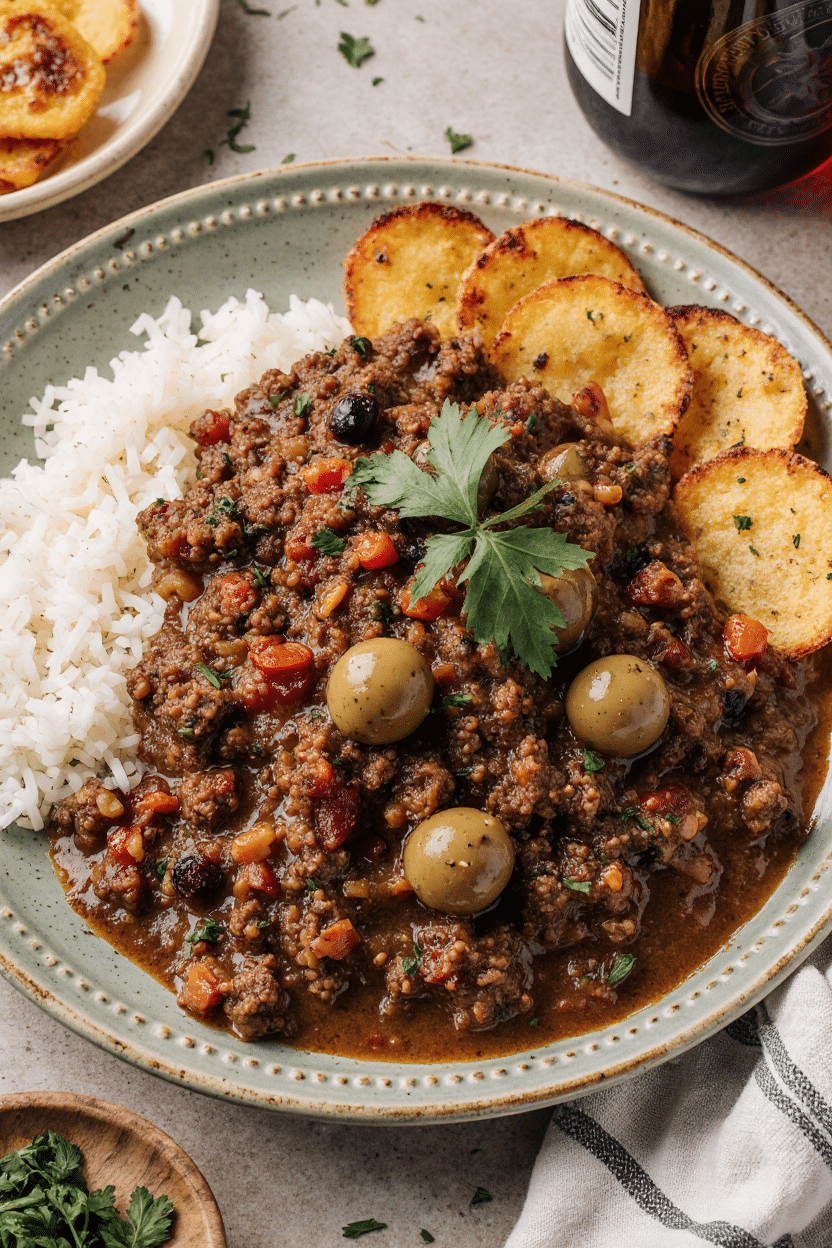The heart of Cuban comfort food lies in dishes like this Cuban Beef Picadillo. A savory and satisfying blend of ground beef, crushed tomatoes, green olives, and a surprise touch of raisins or currants, this dish is both hearty and soul warming. It’s a weeknight hero that brings the rich culture of Havana straight to your table.
Perfect for feeding a hungry family or entertaining a crowd, this dish is deeply flavorful without being fussy. One pan and 45 minutes is all it takes to create a dish that’s layered with spice, texture, and just the right amount of sweetness. Serve it over fluffy white rice or next to crisp fried plantains and watch it disappear fast.
Full Recipe:
Ingredients:
-
1 tablespoon olive oil
-
1 ½ pounds lean ground beef
-
1 medium onion, finely chopped
-
1 small red bell pepper, finely diced
-
4 cloves garlic, minced
-
Salt and freshly ground black pepper, to taste
-
⅓ cup dry white wine (optional)
-
2 teaspoons dried oregano
-
½ teaspoon paprika
-
½ teaspoon cumin
-
1 (14 oz) can crushed tomatoes
-
1 tablespoon tomato paste
-
¼ cup Worcestershire sauce
-
⅓ cup dried currants or raisins
-
½ cup green pitted olives
-
⅓ cup chopped fresh parsley
Directions:
-
Heat olive oil in a large skillet over medium-high heat. Add the ground beef and cook, breaking it up with a spoon, until browned (5–8 minutes). Season with salt and pepper.
-
Reduce heat to medium. Add the onion and bell pepper, cooking until softened (about 3 minutes). Stir in garlic and sauté until fragrant (about 1 minute).
-
Optional: pour in the white wine and scrape the bottom of the pan to deglaze. Let it evaporate.
-
Add paprika, cumin, oregano, crushed tomatoes, tomato paste, Worcestershire sauce, and more salt and pepper if needed. Stir to combine.
-
Cover and simmer over medium-low for 15 minutes.
-
Stir in the currants (or raisins) and olives. Simmer uncovered for another 10–15 minutes until the sauce thickens.
-
Finish with chopped parsley and serve hot with rice or plantains.
Prep Time: 10 minutes | Cooking Time: 35 minutes | Total Time: 45 minutes
Kcal: 255 kcal | Servings: 6 servings
Cuban Beef Picadillo: A Heartfelt Taste of Tradition
Few dishes capture the warmth and complexity of Cuban home cooking like Picadillo a savory-sweet ground beef preparation steeped in heritage and nostalgia. Among the many variations of this Latin American staple, the Cuban version stands out for its balance of rich umami flavors, briny olives, and the gentle sweetness of raisins or currants. It’s hearty, quick to make, and astonishingly versatile, earning its place as a beloved go-to for families across Cuba and far beyond.
In this article, we’ll take a closer look at the history, cultural importance, culinary profile, and the many ways to serve and adapt Cuban Beef Picadillo. Whether you’re a food blogger looking to enrich your readers’ understanding, a curious cook, or simply someone who loves good food with a story, this deep dive into Picadillo will help you understand why this dish has stood the test of time.
A Glimpse into Picadillo’s Origins
The word “Picadillo” is derived from the Spanish verb picar, which means “to chop” or “to mince.” While the dish’s exact origin remains debatable, it’s clear that versions of Picadillo exist throughout Latin America and even the Philippines. It’s a culinary concept rather than a single rigid recipe a mix of ground meat, tomato-based sauce, and add-ins that reflect the culture and pantry staples of the region where it’s made.
The Cuban variation is thought to have evolved during the Spanish colonial era, shaped by the fusion of African, Caribbean, and Spanish influences. What sets it apart from other regional versions, such as Mexico’s spicier or the Philippines’ sweeter Picadillo, is its harmonious medley of sweet, salty, and tangy flavors. The inclusion of olives and raisins, which may seem contradictory to the uninitiated, brings a rounded depth that reflects the Cuban palate: bold, layered, and always with a touch of soul.
Cultural Significance in Cuban Households
In Cuba, Picadillo is more than a dish it’s a comfort food passed down through generations. It’s the kind of recipe that Cuban abuelas (grandmothers) cook with instinct and love, rarely needing to measure ingredients. For many Cuban families, it’s the dish you grew up eating on a regular weekday night but also one you’d find on the table at gatherings and celebrations.
The appeal lies in its familiarity and reliability. It’s nutritious, affordable, and deeply satisfying. Just the aroma of onions sautéing in olive oil, followed by the tang of tomato and the burst of garlic, is enough to evoke memories of laughter-filled kitchens and multigenerational dinners. Cuban Beef Picadillo doesn’t try to be flashy it simply delivers, every single time.
Flavor Profile: A Perfect Balancing Act
What makes Cuban Picadillo unique is its layered flavor structure. At its base, you’ll find sautéed garlic, onions, and bell peppers the classic Cuban sofrito. Ground beef, typically lean but still juicy, forms the hearty core of the dish. From there, it’s all about the additions:
-
Crushed tomatoes and tomato paste deepen the flavor and add a rich base.
-
Green olives bring a briny pop that cuts through the richness of the meat.
-
Raisins or currants introduce a touch of sweetness that offsets the acidity and saltiness in just the right way.
-
Spices like cumin, paprika, and oregano lend warmth and aroma.
-
A splash of white wine or Worcestershire sauce may be added for complexity and umami.
The result is a dish that is slightly sweet, savory, and tangy a profile that dances across your palate and keeps you coming back for more.
Versatility in the Kitchen
One of Picadillo’s greatest assets is its incredible adaptability. It’s essentially a blank canvas for a variety of meals, which is likely a key reason for its staying power in Cuban kitchens. While traditionally served with white rice, its uses are endless:
-
As a filling for empanadas: Spoon the meat mixture into dough rounds, seal, and bake or fry for a portable snack or party appetizer.
-
In tacos or tostadas: Fusion-friendly and ideal for quick weeknight meals.
-
With mashed plantains or fufú de plátano: A satisfying, traditional pairing that elevates the comfort factor.
-
In stuffed peppers: A nutritious twist that adds texture and presentation flair.
-
As a hash for breakfast: Topped with a fried egg, this transforms leftovers into a gourmet morning meal.
-
Over rice or with black beans and Cuban bread: The quintessential way to serve Picadillo, especially in Cuban homes.
Because it refrigerates and freezes well, it’s also a meal-prepper’s dream ready to save the day when you need a flavorful dish on short notice.
Variations and Substitutions
While traditionalists might insist that the true Cuban Picadillo must include raisins and olives, many families tailor the recipe to their own tastes. Some swap in capers for olives, while others leave out the sweet elements entirely. Here are a few common variations:
-
Different proteins: Ground turkey, chicken, or pork can replace beef for a leaner or lighter version.
-
Spice adjustments: For more heat, you can add diced jalapeños or red pepper flakes.
-
Vegetable additions: Chopped carrots, peas, or potatoes can be added for extra texture and nutrition.
-
Plant-based twists: Lentils or crumbled tofu can be used for a vegetarian spin that still honors the dish’s rich flavors.
At its heart, Picadillo is meant to be adapted it’s a dish of the people, meant to work with what’s available and pleasing to those at the table.
Tips for Best Results
If you’re aiming to master Picadillo, here are a few pro tips:
-
Don’t rush the sauté: Let the onions and peppers soften fully to develop a sweeter, deeper flavor.
-
Brown the beef properly: This creates those delicious browned bits that add umami to the sauce.
-
Simmer uncovered at the end: This allows the sauce to thicken and concentrate, so it clings to the meat.
-
Balance the sweet and salty: Taste as you go the right amount of raisins and olives should complement, not overpower.
Why Picadillo Endures
Cuban Beef Picadillo is more than just a meal it’s a celebration of history, culture, and the everyday joy of eating well. Its staying power can be attributed to its simplicity, flavor, and heart. You don’t need fancy equipment or hard-to-find ingredients to make it. What you do need is a little time, a little love, and a willingness to embrace the beautiful contrasts that make Cuban food so irresistible.
It’s no wonder that families continue to pass this dish down through generations. Whether you’re enjoying it over fluffy white rice, tucking it into a warm empanada, or reimagining it as a weekend brunch hash, Picadillo always delivers comfort and satisfaction.
Conclusion:
In a world of ever changing food trends, Cuban Beef Picadillo remains a timeless classic. It’s not flashy, but it is unforgettable the kind of dish that invites you to slow down, sit with loved ones, and savor every bite. It teaches us that great flavor doesn’t require complexity, and that food, when made with intention and tradition, becomes a story we get to relive again and again.
Whether it’s your first time trying Picadillo or your hundredth, there’s always something deeply comforting about this humble dish. It reminds us that some of the best meals are those that connect us to our roots and to each other.






